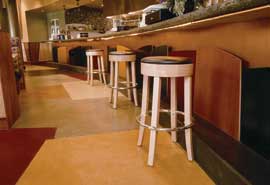Research Stained ConcreteCost, maintenance and more
-
Common Questions
- Do it myself or hire a pro?
- Precautions when applying stain? Buyer's Guide to Concrete Stain Products
- Acid-based stains
- Water-based penetrating stains
- Questions to ask before buying stains Surface Preparation
- Cleaning concrete before staining
- Tips for removing existing flooring Applying Acid Stains
- Basic tools for applying stains
- Secrets to achieving great results
- Six unique looks with concrete stains
- Neutralizing concrete after staining Common Staining Issues
- Troubleshooting common acid staining problems
- Improving Slip Resistance
- Sealer application tips
- Six questions to ask before buying a sealer
Six Questions to Ask Before Buying a Sealer for Stained Concrete
Checklist of Factors to Consider When Choosing a Sealer
Length - 02:42
Although concrete stain is permanent and won't flake off like paint, it penetrates only the top layer of the surface and will eventually wear away as the surface is worn by traffic or weather exposure. You can prevent this wear and prolong the life of your stained concrete by protecting the surface with a clear sealer. Not only will a good sealer help preserve your decorative treatment, it will also bring out the beauty of your stained concrete by enhancing the color and adding sheen.
There are several different types of sealer, each with advantages and limitations (see this comparison chart). To choose the best sealer for your interior or exterior stained concrete, be sure to ask the following questions:
1. Is the sealer compatible with stained concrete?
Be sure to check with the sealer manufacturer to verify the compatibility of its product with the decorative surface it will be applied to. Some sealers may interact with certain types of coloring agents, resulting in discoloration or other unwanted effects.
2. What conditions will the sealer be exposed to?
It's important to select a sealer that will protect your stained concrete from the traffic conditions and elements it will be exposed to. For example, for a stained concrete driveway, you'll need a sealer that repels oil and grease stains, prevents penetration of water and deicing chemicals, and resists abrasion. Sealers for exterior applications should also allow moisture in the slab to escape. For a decorative stained concrete floor, a sealer with good resistance to scuffs and staining will provide the best protection and make the floor easier to maintain.
3. Is the sealer safe to apply indoors?
For interior stained concrete, it's usually safer to use a water-based rather than solvent-based sealer, especially if the area can't be ventilated. Solvent-based sealers are extremely flammable and the fumes they emit can be hazardous to breathe. They also may contain volatile organic compounds (VOCs).
4. What type of gloss level does the sealer provide?
Most sealers are available in a range of sheen levels. If you want to give your stained concrete a glossy look, like polished marble, a sealer with a medium- to high-gloss sheen is a good choice. If you don't want a high shine, you can also find sealers with matte or low-gloss finishes.
5. What is the drying time?
How soon a sealer can be recoated or opened to traffic may be important if you want to use the surface as soon as possible. Acrylic sealers dry the fastest, setting to the touch within 30 to 60 minutes after application and ready for light traffic as soon as 12 hours after the final coat. Polyurethanes and epoxies typically require longer curing times of at least 24 hours.
6. How long will the sealer last?
The life expectancy of a sealer depends, in part, on exposure conditions and how well the sealer is maintained. In general, however, epoxies and urethanes deliver the best long-term performance and can last years before the need for reapplication.

Photo: Select Coatings, Inc.
Related Information
For more advice about choosing a concrete sealer, read The Concrete Network's Shop Smart Guide to Buying Concrete Sealers.





